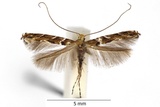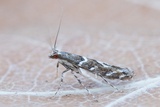Acrocercops brongniardella (Fabricius, 1798) Species
Last modified: Dec. 10, 2025, 1:17 p.m.
A fairly common species in Belgium.
Details
- Classification
- Family: Gracillariidae > Subfamily: Acrocercopinae > Genus: Acrocercops > Species: Acrocercops brongniardella
- Vernacular names
- Zilvermijnmot (NL), Brown oak slender (EN)
- Synonyms
- Acrocercops quercetella (Zeller, 1839)
- First mention in Belgium
- De Fré Ch. 1858. Catalogue des Microlépidoptères de la Belgique. — Annales de la Société entomologique belge 2: 45–162. On page 147 (as quercetellum). view page
- Status
-
Native
Distribution
Caterpillar
The early stages of the larva have nearly the same colour as the leaf in which they mine, light yellowish green. Later on they turn into a vivid red with ochreous yellow between the segments.
Mine
The mine is almost always situated on the upper side of the leaf. It starts as a narrow, whitish, twisting mine that suddenly enlarges into a large, pure white blotch with a silvery shine, occupying several cm².
See also gracillariidae.net and bladmineerders.be.
Cocoon/pupa
A small, whitish, oval pupation chamber most of the time on the midrib of a leaf.
Bionomics
The adults are rarely seen. They rest on tree trunks during daytime and come to light. The species hibernates in the adult stage.
Flight periods
There is one generation a year in June and July, after hibernation in April–May of the next year.
Observed on
- Host plant (species):
- Quercus robur
- Host plant (genera):
- Quercus
The larvae are oligophagous on Quercus, but in Belgium the species is mostly recorded from Quercus robur.
Habitat
Because Quercus is a common tree in Belgium, the variety of habitats in which the species occurs is also rather large. Anyway, the species seems to avoid moist environments and has some preference for dry, warm habitats like heathland, open places in forests, parks, etc.





